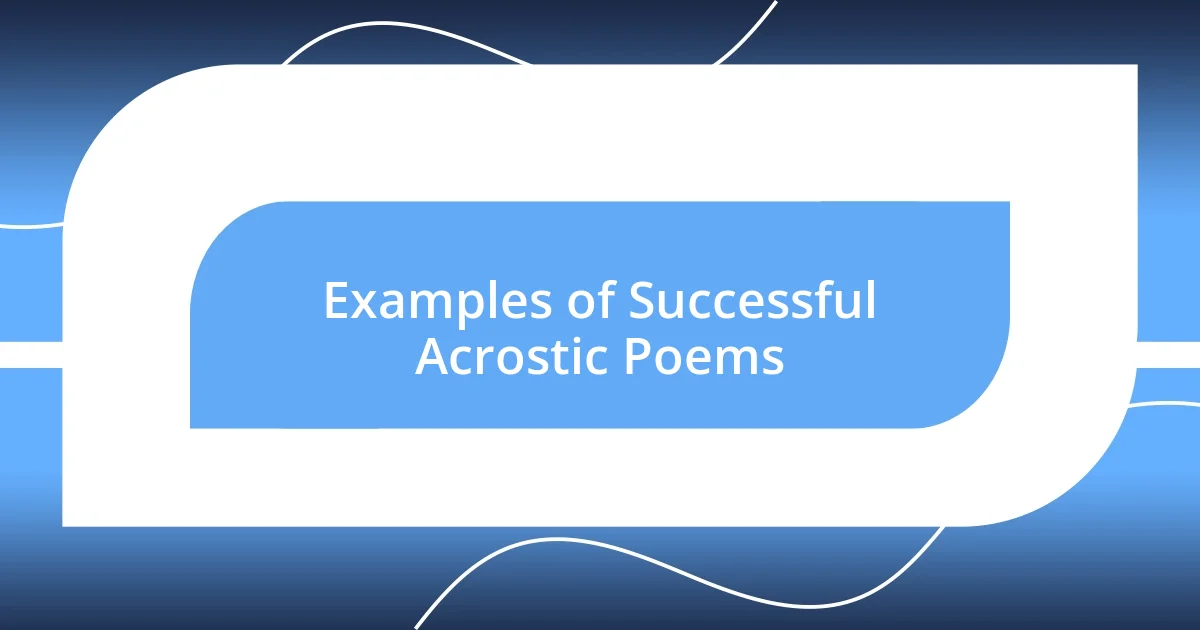Key takeaways:
- Acrostic poems creatively express emotions by spelling out words vertically with the first letter of each line, enhancing both vocabulary and personal reflection.
- Effective techniques for writing acrostics include starting with a strong word, using synonyms for deeper meaning, and incorporating vivid imagery to engage readers.
- Exploring themes in acrostic poems allows for self-discovery and connection with personal experiences, illustrating how a single word can evoke complex emotions and insights.

Understanding Acrostic Poems
Acrostic poems are unique in that the first letter of each line spells out a word or message when read vertically. I remember the first time I crafted one for my best friend’s birthday; it felt immensely satisfying to embed a personal touch into the poem while celebrating her qualities. Isn’t it thrilling to think your words can have a hidden dimension?
As I delved deeper into acrostic poetry, I realized that these poems are not just fun; they’re also a great way to enhance creativity. The process of selecting words that not only begin with the right letters but also convey meaningful sentiments can be a delightful challenge. Have you ever found yourself stuck on a phrase, only to suddenly stumble upon the perfect word that completes both the acrostic and your message?
I often use acrostic poems as a tool in my workshops to spark creativity among participants. The layout encourages them to think outside the box, fostering a sense of community as they share their creations. Through this medium, I’ve seen individuals express emotions they struggled to articulate otherwise—doesn’t that highlight the beautiful power of words?

Benefits of Writing Acrostic Poems
Writing acrostic poems offers a host of benefits that can enhance both creativity and emotional expression. For instance, I recently guided a group of young students in creating their own acrostics. Watching their faces light up as they discovered how their chosen words could convey their feelings was truly rewarding. It’s a simple yet profound way to communicate complex emotions, all while having fun with language.
Here are some key benefits of writing acrostic poems:
- Enhances vocabulary: Crafting an acrostic encourages the exploration of new words, enriching one’s lexicon.
- Boosts creativity: The challenge of finding fitting words sparks inventive thinking and imaginative expression.
- Cultivates emotional depth: This format provides a safe space to articulate feelings and personal experiences.
- Fosters collaboration: Sharing acrostic creations can inspire others and build connections within a group.
- Encourages personal reflection: Writing an acrostic prompts introspection on values, memories, and aspirations, leading to deeper self-awareness.

Techniques for Creating Acrostic Poems
In my experience, one of the most effective techniques for creating acrostic poems is to start with a strong word that resonates with you. Once you have your chosen word, I recommend jotting down feelings or images linked to each letter. For instance, when I crafted an acrostic for “LOVE,” each letter spurred a memory that perfectly captured my emotions at the time—L for laughter, O for opportunities shared, V for vulnerability, and E for enduring support. It felt like piecing together a mosaic of my thoughts and feelings.
Another technique I find engaging is to use synonyms or related concepts for each letter of your acrostic. Instead of merely focusing on direct meanings, exploring alternative perspectives can deepen your poem’s impact. For example, when writing about “FRIEND,” I thought about trust, adventure, reliability, inspiration, empathy, and nurturing. Taking this route invites a richer exploration of your theme, allowing readers to connect on multiple levels.
Lastly, consider incorporating imagery to make your acrostic poem more vivid. This technique invites readers to visualize what you’re expressing, enriching their experience. I’ll never forget the acrostic I created for “NATURE,” where I described the sights and sounds of a forest—N for the nurturing sun, A for the aroma of pine, T for the trickling creek, U for the unique wildlife, R for rustling leaves, and E for endless beauty. This approach transformed my acrostic into a lush sensory experience, drawing readers in closer.
| Technique | Description |
|---|---|
| Start with a Strong Word | Choose a word that evokes strong emotions, then brainstorm related feelings for each letter. |
| Use Synonyms | Explore synonyms or related concepts for each letter to enrich your poem’s meaning. |
| Incorporate Imagery | Utilize vivid imagery to create a sensory experience that engages the reader. |

Exploring Themes in Acrostic Poems
When I sit down to write an acrostic poem, I often find myself reflecting on the broader themes that emerge from the chosen word. For instance, while exploring the word “FAMILY,” I unearthed not just immediate associations of love and support, but also the complexities of relationships like loyalty, growth, and sometimes conflict. Don’t you find it fascinating how one simple word can unlock an entire world of themes?
I remember crafting an acrostic with “DREAM,” and it opened a floodgate of emotions for me. Each letter I penned—D for determination, R for resilience, E for empowerment, A for aspiration, and M for motivation—resonated deeply. It made me realize how interconnected our dreams are with our personal journeys and growth. This experience taught me that themes in acrostic poems can reflect our most profound aspirations and feelings, inviting readers to embark on a personal exploration alongside us.
Ultimately, I’ve found that the themes within acrostic poems can also serve as a mirror for self-discovery. As I wrote about “HOPE,” each letter revealed different aspects of what hope means to me personally: H for healing, O for opportunities, P for persistence, and E for encouragement. Engaging with these themes allowed me to re-evaluate my outlook on life and the crucial role hope plays in it. Isn’t that a beautiful way to connect with our innermost thoughts? I’m curious—what themes resonate with you in your writing journey?

Examples of Successful Acrostic Poems
Creating successful acrostic poems can truly illuminate the beauty of language and personal expression. One memorable example was when I wrote an acrostic for “HEART.” Each letter—H for hope, E for empathy, A for affection, R for resilience, and T for trust—helped me explore the intricacies of human connection. The process felt deeply reflective, reminding me how each element intertwines to form the essence of relationships.
Another standout moment was when I decided to craft an acrostic using “PEACE.” Here, I captured P for patience, E for equanimity, A for awareness, C for compassion, and E for equilibrium. The words flowed effortlessly because they resonated with my desire for inner serenity amidst life’s chaos. It was as if writing this poem opened a pathway to mindfulness, where I could share my thoughts and encourage others to seek their own peace.
I also recall a time when I explored the word “WINTER” through an acrostic. Each letter sparked vivid imagery: W for white snowflakes drifting softly, I for icy breaths visible in the frigid air, N for the night sky filled with shimmering stars, T for the tranquility that blankets the world, E for evergreen trees standing tall, and R for the roaring fires that invite warmth and conversation. This experience not only captured the essence of the season but also allowed me to convey a yearning for comfort during the cold months. Isn’t it incredible how acrostic poems can weave together such rich imagery and emotional depth?

Tips for Improving Acrostic Writing
When I set out to improve my acrostic writing, I always start with a strong word that resonates with me. For example, I once chose “COURAGE,” which immediately made me think of the challenges I’ve faced and overcome. As I crafted each line, I felt inspired to be more authentic, allowing my emotions to shape the words naturally. Have you ever sat with a word that just clicked for you? Those moments can truly transform your writing experience.
Another invaluable tip is to use vivid imagery and sensory details. I remember writing an acrostic for “SAND,” where S became “shimmering in the sunlight,” A turned into “a grainy texture underfoot,” N became “nestled in the dunes,” and D was “drifting with the breeze.” Each letter didn’t just describe— it made me feel like I was right there on the beach. The more you can paint a picture, the more you invite readers into your emotional landscape. What images come to mind when you think of your words?
Lastly, revisiting your acrostic poem after some time can unveil fresh insights. I’ve had pieces that felt complete initially, but later I noticed areas where I could deepen the message. For instance, my acrostic for “LOVE” sparked new thoughts about vulnerability and trust after reflecting on my relationships. By allowing time for introspection, I was able to enhance my writing and share something more profound. Do you ever find that stepping back opens up new depths in your own work?












